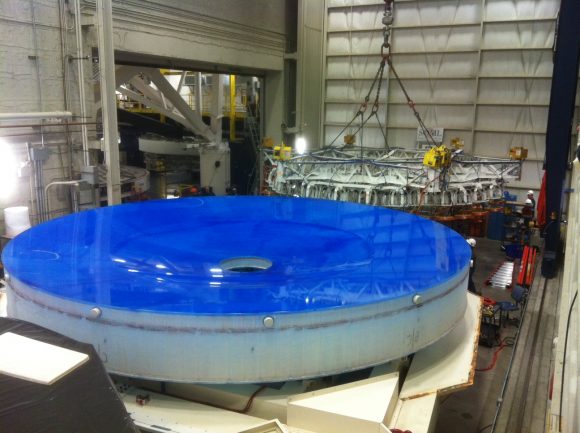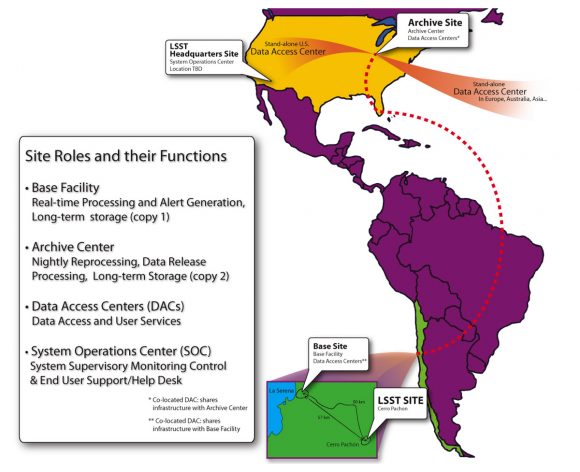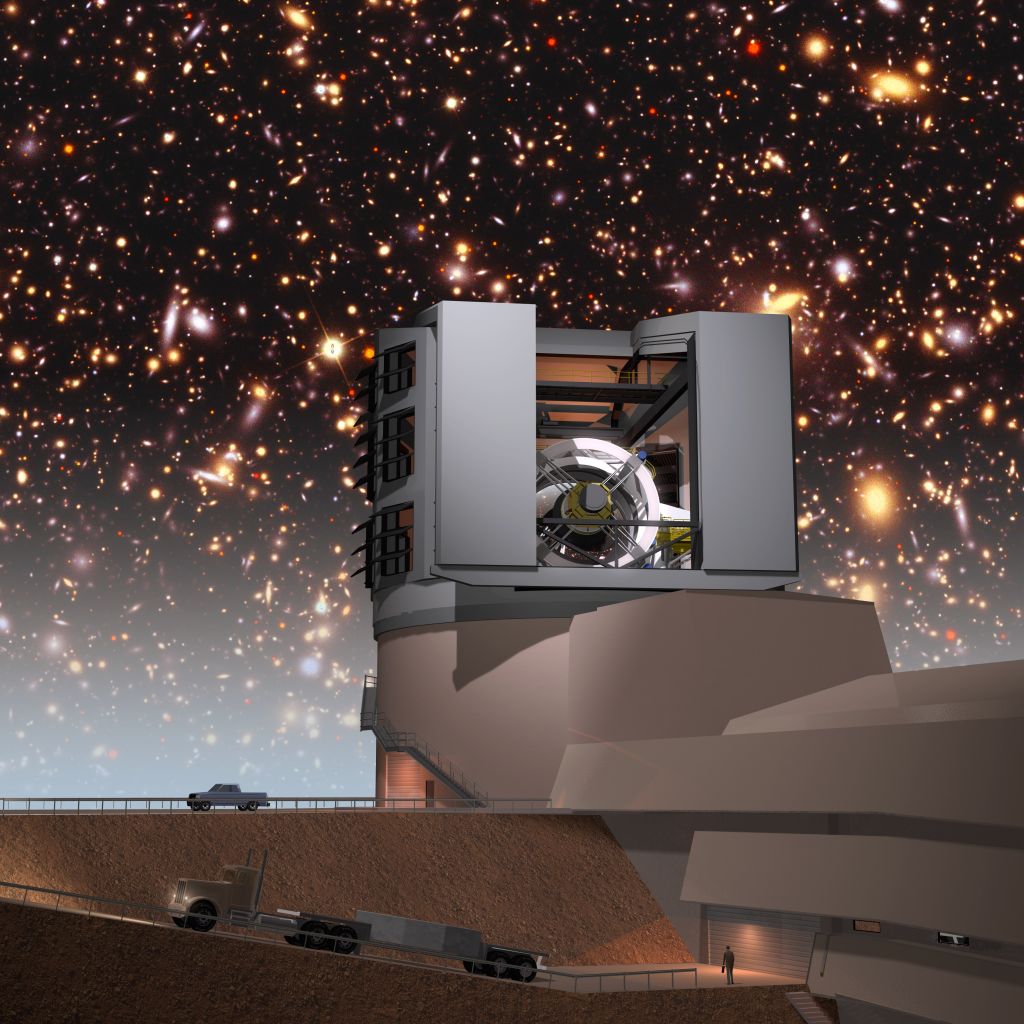We humans have an insatiable hunger to understand the Universe. As Carl Sagan said, “Understanding is Ecstasy.” But to understand the Universe, we need better and better ways to observe it. And that means one thing: big, huge, enormous telescopes.
In this series we’ll look at 6 of the world’s Super Telescopes:
- The Giant Magellan Telescope
- The Overwhelmingly Large Telescope
- The Thirty Meter Telescope
- The European Extremely Large Telescope
- The Large Synoptic Survey Telescope
- The James Webb Space Telescope
- The Wide Field Infrared Survey Telescope
The Large Synoptic Survey Telescope
While the world’s other Super Telescopes rely on huge mirrors to do their work, the LSST is different. It’s a huge panoramic camera that will create an enormous moving image of the Universe. And its work will be guided by three words: wide, deep, and fast.
While other telescopes capture static images, the LSST will capture richly detailed images of the entire available night sky, over and over. This will allow astronomers to basically “watch” the movement of objects in the sky, night after night. And the imagery will be available to anyone.
The LSST is being built by a group of institutions in the US, and even got some money from Bill Gates. It will be situated atop Cerro Pachon, a peak in Northern Chile. The Gemini South and Southern Astrophysical Research Telescopes are also situated there.
The Camera Inside the ‘Scope
At the heart of the LSST is its enormous digital camera. It weighs over three tons, and the sensor is segmented in a similar way that other Super Telescopes have segmented mirrors. The LSST’s camera is made up of 189 segments, which together create a camera sensor about 2 ft. in diameter, behind a lens that is over 5 ft. in diameter.
Each image that the LSST captures is 40 times larger than the full moon, and will measure 3.2 gigapixels. The camera will capture one of these wide-field images every 20 seconds, all night long. Every few nights, the LSST will give us an image of the entire available night sky, and it will do that for 10 years.
“The LSST survey will open a movie-like window on objects that change brightness, or move, on timescales ranging from 10 seconds to 10 years.” – LSST: FROM SCIENCE DRIVERS TO REFERENCE DESIGN AND ANTICIPATED DATA PRODUCTS
The LSST will capture a vast, movie-like image of over 40 billion objects. This will range from distant, enormous galaxies all the way down to Potentially Hazardous Objects as small as 140 meters in diameter.

There’s a whole other side to the LSST which is a little more challenging. We get the idea of an in-depth, moving, detailed image of the sky. That’s intuitively easy to engage with. But there’s another side, the data mining challenge.
The Data Challenge
The whole endeavour will create an enormous amount of data. Over 15 terabytes will have to be processed every night. Over its 10 year lifespan, it will capture 60 petabytes of data.
Once data is captured by the LSST, it will travel via two dedicated 40 GB lines to the Data Processing and Archive Center. That Center is a super-computing facility that will manage all the data and make it available to users. But when it comes to handling the data, that’s just the tip of the iceberg.
“LSST is a new way to observe, and gaining knowledge from the Big Data LSST delivers is indeed a challenge.” – Suzanne H. Jacoby, LSST
The sheer amount of data created by the LSST is a challenge that the team behind it saw coming. They knew they would have to build the capacity of the scientific community in advance, in order to get the most out of the LSST.

As Suzanne Jacoby, from the LSST team, told Universe today, “To prepare the science community for LSST Operations, the LSST Corporation has undertaken an “Enabling Science” effort which funds the LSST Data Science Fellowship Program (DSFP). This two-year program is designed to supplement existing graduate school curriculum and explores topics including statistics, machine learning, information theory, and scalable programming.”
The Science
The Nature of Dark Matter and Understanding Dark Energy
Contributing to our understanding Dark Energy and Dark Matter is a goal of all of the Super Telescopes. The LSST will map several billion galaxies through time and space. It will help us understand how Dark Energy behaves over time, and how Dark Matter affects the development of cosmic structure.
Cataloging the Solar System
The raw imaging power of the LSST will be a game-changer for mapping and cataloguing our Solar System. It’s thought that the LSST could detect between 60-90% of all potentially hazardous asteroids (PHAs) larger than 140 meters in diameter, as far away as the main asteroid belt. This will not only contribute to NASA’s goal of identifying threats to Earth posed by asteroids, but will help us understand how planets formed and how our Solar System evolved.
Exploring the Changing Sky
The repeated imaging of the night sky, at great depth and with excellent image quality, should tell us a lot about supernovae, variable stars, and possible other events we haven’t even discovered yet. There are always surprising results whenever we build a new telescope or send a probe to a new destination. The LSST will probably be no different.
Milky Way Structure & Formation
The LSST will give us an unprecedented look at the Milky Way. It will survey over half of the sky, and will do so repeatedly. Hundreds of times, in fact. The end result will be an enormously detailed look at the motion of millions of stars in our galaxy.
Open Access
Perhaps the best part of the whole LSST project is that the all of the data will be available to everyone. Anyone with a computer and an internet connection will be able to access LSST’s movie of the Universe. It’s warm and fuzzy, to be sure, to have the results of large science endeavours like this available to anyone. But there’s more to it. The LSST team suspects that the majority of the discoveries resulting from its rich data will come from unaffiliated astronomers, students, and even amateurs.
It was designed from the ground up in this way, and there will be no delay or proprietary barriers when it comes to public data access. In fact, Google has signed on as a partner with LSST because of the desire for public access to the data. We’ve seen what Google has done with Google Earth and Google Sky. What will they come up with for Google LSST?
The Sloan Digital Sky Survey (SDSS), a kind of predecessor to the LSST, was modelled in the same way. All of its data was available to astronomers not affiliated with it, and out of over 6000 papers that refer to SDSS data, the large majority of them were published by astronomers not affiliated with SDSS.
First Light
We’ll have to wait a while for all of this to come our way, though. First light for the LSST won’t be until 2021, and it will begin its 10 year run in 2022. At that time, be ready for a whole new look at our Universe. The LSST will be a game-changer.


I was told by someone who had worked there that the data processing for the Large Hadron Collider has to cope with some 12TB/sec. so big data challenges of this scale have been tackled before. I also know that Image recognition systems using multi-dimensional matrix techniques can detect differences or similarities in A4 document sized bitonal images (~9 Megapixels) in tens of milliseconds but there’s still a hill to climb, not least making the data as accessible as the excellent SDSS.
This is a great article, that I really enjoyed reading. Thanks for sharing.
Json Converter